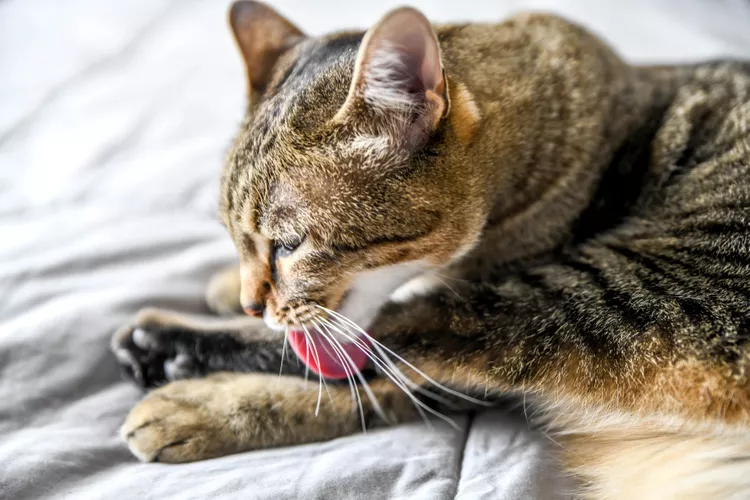Reasons Why Your Cat is Overgrooming and How to Stop It

Your cat overgrooming may be for medical reasons or behavioral reasons; she may be nursing a wound or really stressed out. By treating the cause of the stress and adding stress-relieving activities and pheromones to your cat's day, you can help put a stop to your cat overgrooming.
What Is Overgrooming in Cats?
Overgrooming is when a cat spends an abnormally large amount of time obsessively grooming itself. This can result in hair loss and skin sores. When a cat licks itself, endorphins, which are natural "feel good" neurotransmitters made by the brain, are released. These endorphins are the chemicals that make the sensation of self-grooming feel comforting. Therefore, if your cat is stressed, it may resort to this comforting behavior.
Cat owners typically say that they never see their cats indulge in lick-fests. This may be because the kitty feels more comfortable when its person is in sight and doesn't feel the urge to self-calm via licking.
When the owner isn't present, the cat may begin to feel uncomfortable and partake in overgrooming. If you do happen to witness your cat overgrooming, don't punish it. This will only create additional stress and may exacerbate the problem.
What Causes Cat Overgrooming?
The pervasive type of stress that usually causes psychogenic alopecia is likely to be chronic and consists of a number of combined stressors, such as permanent changes in the routine and environment. This could include the absence of a certain family member because of death, divorce, longer work hours, vacation, or departure for college, in addition to:
- The arrival of a new furry friend or human family member
- Moving to a new apartment or house
- Rearranging some or all of the furniture
- Moving the litter box to another location
- Lack of environmental enrichment for the kitty
- Living in a chaotic household
Other cats may overgroom because of medical reasons. For example, if something is causing your cat to be itchy, it may overgroom in an attempt to relieve the itch. Cats can have allergies to food, fleas, or other elements of their environment. Consider any recent dietary or environmental changes that could underlie this behavior. If you think your cat might have an allergy, consider making an appointment with a specialized veterinary dermatologist, who can test your kitty to determine if this is the cause.
Signs of Cat Overgrooming
If your cat is overgrooming, you'll see a line or stripe of very short stubble that looks like a buzz-cut. It can occur anywhere on your cat's body but is most common on a foreleg, an inner thigh, or the belly. If the behavior is severe, the skin underneath the fur may become damaged, appearing red, or sore.
How to Stop the Overgrooming
You’ll need a veterinarian to rule out any medical conditions and confirm the diagnosis of psychogenic alopecia. In the meantime, try to figure out the reason your cat is feeling anxious. If you can identify the cause and eliminate it, the behavior may gradually go away on its own. You can also try a few tips to help ease your cat's anxiety and overgrooming behavior:
- If your cat is experiencing separation anxiety from someone, ask the person to leave behind an unwashed shirt or blanket in a sealed ziplock bag. This could give your upset kitty a scented pick-me-up.
- Introduce a new cat gradually to reduce stress levels in both. Even confident cats may suffer from hidden stress that manifests itself as nervous licking.
- Play therapy is also a great stress reliever. It can help build your kitty's self-confidence and help it associate a positive experience with the new house or a new pet or person. Interactive games are best, such as chase-the-fishing-pole lure or laser tag for cats.
- A spray or plug-in pheromone product, like Feliway, can be helpful to relieve stress. Feliway and other synthetic-pheromone products are similar to the scent cats naturally produce. You can spray it or rub it on objects, and it has a calming effect.
During your next vet visit, the doctor will rule out any medical reasons for your cat overgrooming. This could include allergies, flea infestation, skin mites, ringworm, bacterial or fungal infections, or metabolic conditions, like hyperthyroidism. Skin biopsies, lab work, and a thorough physical exam can all be helpful to your vet in making the right diagnosis, with any medical treatment will vary based on the vet's findings.
In most cases without a medical diagnosis, excessive licking behaviors require anti-anxiety drug therapy prescribed by a vet to break the licking cycle. Typically the cat does not have to be on these medications its entire life, just for a period of time to help the animal deal with stress. Always follow your veterinarian's instructions if your cat is placed on any anti-anxiety medication. Any medication or training for this behavior takes time and patience to see an effect.
Know that any treatment solutions for psychogenic alopecia may not be permanent. If your cat tends to overgroom, this may recur at any time and could be an indicator that your cat is feeling stressed again.